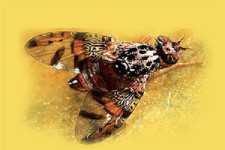Managing Fruit Flies

The species is native to sub-Saharan Africa and is not known to be established in the continental U.S. When it has been detected in the U.S., infestations have necessitated massive eradication and detection procedures to prevent establishment.
Because of its wide distribution, its ability to tolerate cooler climates than most species of fruit flies, and its wide host range, it is ranked first among economically important fruit fly species. Medflies breed continuously when host fruits are available.
The pest can move rapidly. Once established, eradication efforts may be extremely difficult and expensive. In addition to reduction of crop yield, infested areas have the additional expense of control measures and costly sorting processes for both fresh and processed fruit and vegetables.
An important tool used to control this pest is the release of sterile Medflies, a biologically-based reproduction control method. Since 2002, a cooperative effort between USDA and Florida Department of Agriculture and Consumer Services Division of Plant Industry initiated a program where millions of sterile Medflies are released throughout high-risk areas to prevent potential infestations.









